Pierre Boucher's stained-glass window in the Church Notre-Dame of Mortagne-au-Perche
Introduction
Text-to-speech Audio
Rebuilt after the Hundred Years War, L’Eglise Notre-Dame de L’Assomption (1494-1535) in Mortagne-au-Perche is known locally for its exceptional stained-glass windows, which date from the Renaissance to the 20th Century and represent everything from the Virgin Mary to Pierre Boucher, the governor of Trois Rivières in Québec. This last window, placed between two scenes of the Old Testament, tells the story of Pierre Boucher’s exploits in Nouvelle France, as well as the emigration stories of everyday Perche inhabitants who followed him to the faraway America in the seventeenth century.
Images
Eglise Notre Dame Mortagne-au-Perche
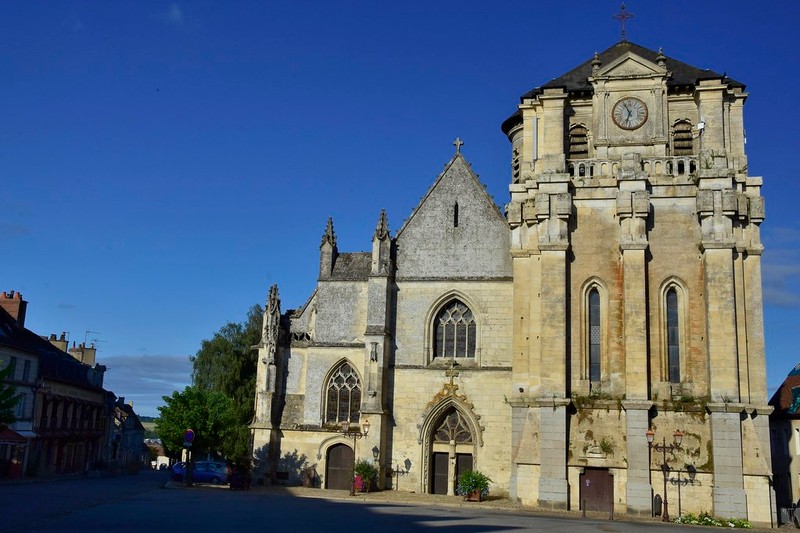
Stained Glass window depicting the life of Pierre Boucher
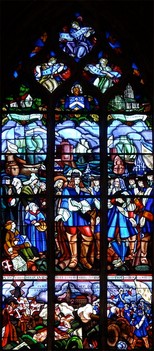
Inside view of the Church Notre Dame
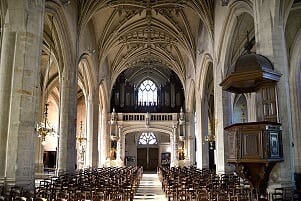
Bottom piece of the window: the Trois-Rivieres siege in 1653
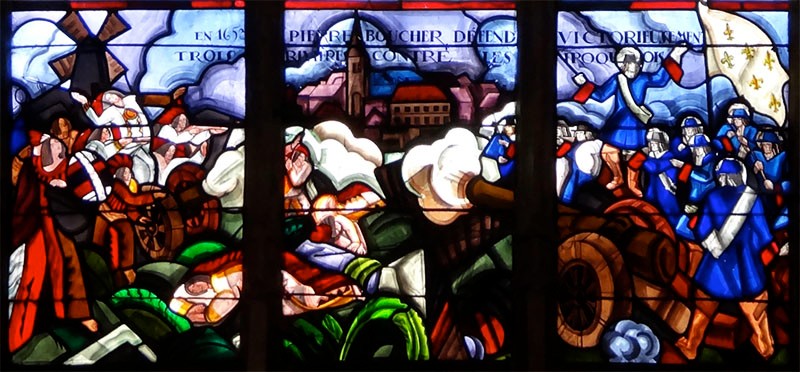
Center piece of the window: Departure from LaRochelle in 1662
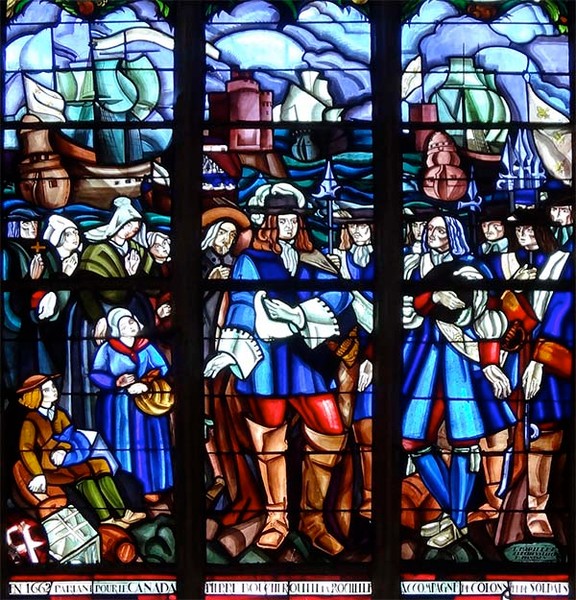
Top piece of the window
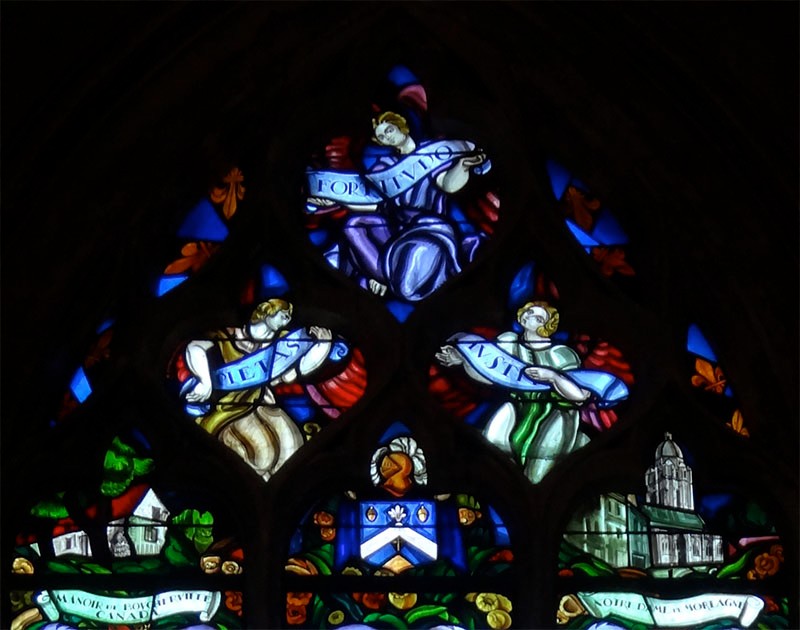
portrait of Pierre Boucher
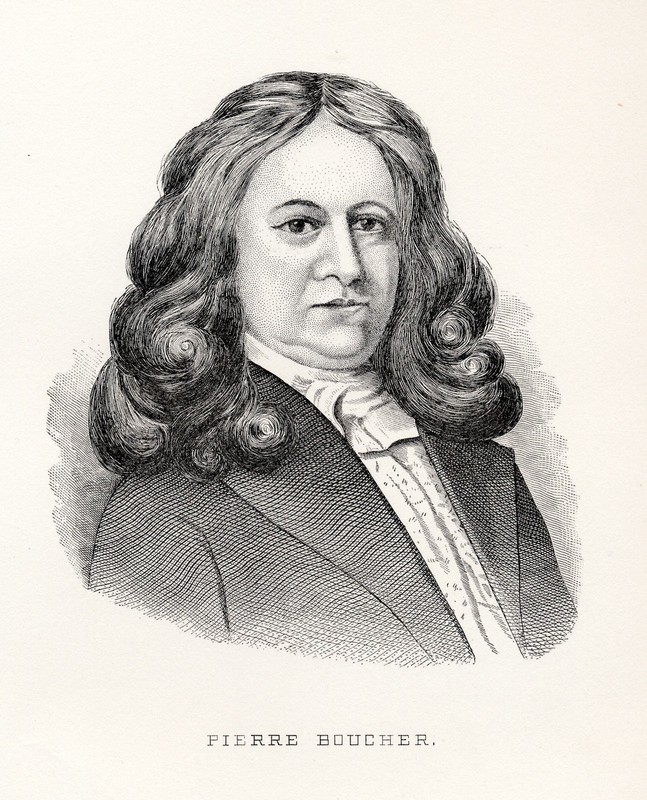
Map depicting Mortagne au Perche and Tourouvre
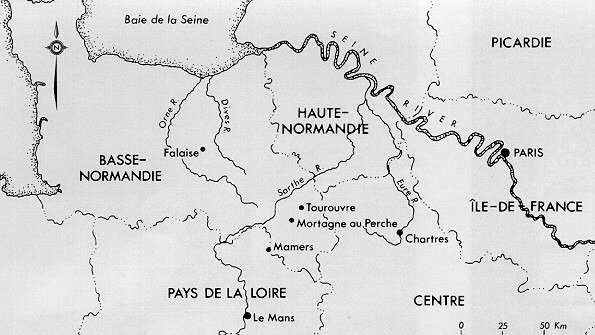
Backstory and Context
Text-to-speech Audio
In April 1634, carpenter Gaspard Boucher and twenty-six other Perchois emigrants followed Robert Giffard across the Atlantic Ocean to settle along the Saint-Laurent River in what is now Québec. This marked the first Perchois immigrant wave to Canada. In total, 246 Perchois emigrated to Nouvelle France in the fifteen years that followed.
Boucher returned to Mortagne-au-Perche a year later to move his family, including his thirteen-year-old son Pierre, across the Atlantic. The founding of settlements, particularly of Jesuit missions, all over Nouvelle France kept Gaspard Boucher busy and allowed for his son Pierre to receive an uncommon education. Pierre not only learned how to read and write with the Jesuits, but also how to speak the Huron language. Thanks to these skills, in 1640, Québec governor Huault de Montmagny took him into his service as a soldier and an interpreter. He soon made himself indispensable: his presence is recorded at numerous key events in the colony's history, including important treaties with First Nations.
Pierre Boucher moved to Trois Rivières in 1644, and was promoted to Captain in 1651. For the next two years the town found itself under constant threats: a first attack in 1652 took the life of twenty-seven settlers, including the governor of Trois Rivières, and in 1653 a force of 600 Iroquois encircled the town, defended only by Pierre Boucher and 40 settlers. The 1653 Trois-Riviere siege is depicted on the bottom part of the stained-glass window, as is explained by the slightly erroneous legend “En 1652, Pierre Boucher defend victorieusement Trois-Rivieres contre les Iroquois.” (In 1652, Pierre Boucher victoriously defends Trois-Rivieres against the Iroquois).
This success lead to his appointment as Governor of Trois Rivières in 1654. Yet illness and warfare had decimated the already small French population in Québec. In 1661, Pierre Boucher returned to France in a bid to gather supplies and soldiers and to recruit migrants to New France. After collecting funds from the famed Companie des Cents Associés, Pierre Boucher returned to his native region of Perche in search of such settlers.
The center part of the stained-glass window shows Pierre Boucher’s 1662 departure from La Rochelle. He is represented in the center, surrounding with a hundred soldiers and about as many Perchois emigrants. This marked the single largest Perchois emigration to the New World, even though sixty migrants died on the voyage. In the seventeenth century the Perchois population made up only 5% of Québec’s French population. However, the patriarchal tradition of keeping only patronyms allowed Perchois last names to descend through the generations: they are now omnipresent in Québec, representing 20% of the top 100 last names during the 2001 region census. More than half a million of the French speaking population of Québec today are descendant from these original 246 Perchois. Many famous French Canadians like Celine Dion, Justin Biber, Justin Trudeau and even Hillary Clinton can be linked back to Perchois ancestors.
Although Québec was lost to the English with the 1763 Treaty of Paris, strong links remain between French Canada and France, particularly the Perche. In 1891, Honore Mercier, then Québec’s liberal prime minister, visited Mortagne-au-Perche and Tourouvre -the two main cities from which the emigrants came from. This marked the first official visit from a Québec politician to the Perche. Honore Mercier himself descended from Julien Mercier, a famed Perchois emigrant represented in a stained-glass window in a church in Tourouvre, north of Mortagne-au-Perche. Newspapers in France and in Canada, titled Mercier's visit “Les retrouvailles” (The reunion).
In the twentieth century, particularly in the years leading up to the Quiet Revolution, Quebecois people placed increased importance on traditional language and culture. In that context, the Perche-Québec association was created in 1956 in an aim to strengthen the cultural ties between the two regions and sponsor research on Perchois emigration. The Quiet Revolution brought radical changes to Québec’s society, empowering the francophone population through societal and economic innovations, along with the spread of nationalist ideas and a push for the political independence of Québec. Since then, both regions have worked together to reinforce their cultural links, as well as reaffirm Québec’s difference with the rest of Canada. In June 2000, Jean Chrétien, ex-liberal prime minister of Canada, visited Tourouvre and Mortagne-au-Perche, marking the political importance of the cultural links between the Perche and French Canadians. In 2006, the same year as the Canadian Parliament officially recognized Québec as a nation within its borders, the Emigration Museum was opened in Tourouvre with the help of both French and Canadian contributors.
Sources
- Allan Thompson. "Chretien Retraces History." Toronto Star, June 24, 2000, Edition 1. https://advance.lexis.com/api/document?collection=news&id=urn:contentItem:40JT-XWC0-006F-035B-00000-00&context=1516831.
- Douville, Raymond. "Boucher, Pierre" in Dictionary of Canadian Biography. Volume 2. University of Toronto/Université Laval, 2003. http://www.biographi.ca/en/bio/boucher_pierre_2E.html.
- Mayes, Hubert G. "Je me souviens." The Beaver, July 1, 1991, pg. 26.
- O’Neil, Peter. "Strength in Numbers; Two-Thirds of French Canadians Can Trace Their Roots to 283 Early Settlers." National Post (Toronto), March 15, 2008.
"Visite guidée de Mortagne-au-Perche", Guides de France, 2015, https://www.tour-guides.fr/visite/visite-guidee-de-mortagne-au-perche/
"Perche-Quebec individus, Pierre Boucher", perche-quebec webpage, 2014, https://www.perche-quebec.com/perche/individus/boucher-gaspard.htm#6
"Perche-Quebec individus, Pierre Boucher", perche-quebec webpage, 2014, https://www.perche-quebec.com/perche/individus/boucher-gaspard.htm#6
"Perche-Quebec individus, Pierre Boucher", perche-quebec webpage, 2014, https://www.perche-quebec.com/perche/individus/boucher-gaspard.htm#6
"Perche-Quebec individus, Pierre Boucher", perche-quebec webpage, 2014, https://www.perche-quebec.com/perche/individus/boucher-gaspard.htm#6
"Perche-Quebec individus, Pierre Boucher", perche-quebec webpage, 2014, https://www.perche-quebec.com/perche/individus/boucher-gaspard.htm#6
"Perche-Quebec individus, Pierre Boucher", perche-quebec webpage, 2014, https://www.perche-quebec.com/perche/individus/boucher-gaspard.htm#6
